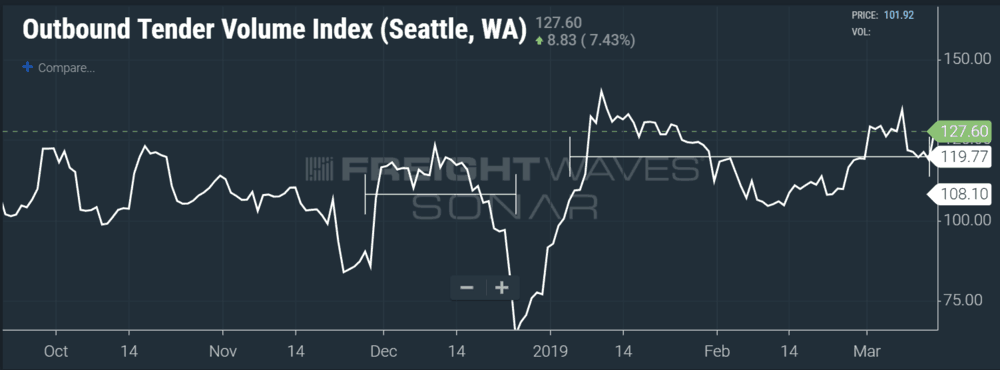The clocks may have sprung forward but freight volume fell back. National volumes have been receding this week after a strong first week of March. The Outbound Tender Volume Index dropped 3% since last Wednesday. What looked like a typical beginning of the spring freight season has turned into something that resembles a fall pattern, where volumes slide downward. Little has changed on the capacity side as well, with national tender rejection rates continuing to fall gradually, dropping below 7% for the first time since the index’s inception in early 2018.
Last week it appeared the Los Angeles market was starting to show signs of deterioration, with volumes falling over 20% on a week over week basis. That trend has stalled a bit, but volumes continue to be weaker out of the L.A. market than they have been for most of 2019. The Outbound Tender Volume Index for L.A. is averaging 11% lower in the past week versus the previous eight weeks.
It should be noted that the volumes are still relatively high, historically speaking, but the trend has started to change. A lot of the West coast appears to be loaded with potential freight after what was a record year for inbound container volumes into the ports in L.A. It appears that a lot of that freight is still sitting in the western markets as warehouses are reportedly at capacity in many areas, and tracking the freight movements over the past few months would support this theory.
There have been a few markets starting to show signs of emergence over the past week with sustained upward movement. Most notably, the nation’s third largest market, Joliet, just to the west of Chicago has been gradually increasing since it bottomed in the middle of January. Yesterday the Outbound Tender Volume Index for that market increased 6.1%. Joliet represents 4.6% of the total load volume in the U.S. currently, so any movement can have an impact on national capacity. With national volumes roughly 3% down from 2018 levels, most increases in larger markets have been easily consumed by carriers keeping tender rejection rates low.
 Seattle outbound volumes are higher than normal for this time of year. (Image: SONAR chart of the Outbound Tender Volume Index for Seattle)
Seattle outbound volumes are higher than normal for this time of year. (Image: SONAR chart of the Outbound Tender Volume Index for Seattle)
Surprisingly, the Pacific Northwest continues to show signs of strength in what is typically a down cycle for the region in terms of freight movement. The largest market in the region, Seattle, is averaging 11% higher volumes versus the normally busier month of December, 48% higher than this time last year.
The neighboring markets of Spokane and Portland have also had relatively high outbound volumes this winter with Portland being up 29% and Spokane climbing 8% in the past week. Tender rejection rates for the region have been subdued but volatile, bouncing between 7% and 12% over the past week. It is unclear what is causing this nonseasonal volume, but the fact Seattle is a port city may be a big reason, as volumes have been elevated in most of the major port markets across the U.S.
Looking forward, there continues to be little evidence of a seasonal shift outside the first week of March, which appears to be fading. Activity is still elevated over late January and February, but capacity is readily available which should keep rates depressed.










